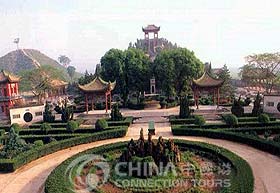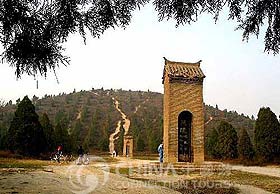
 Located in the area of Duima of Weibei Highland, nine kilometers northeast of Xingping County and 40 kilometers from Xi'an, Maoling, the mausoleum of Emperor Wu Di is most known as the largest of the five mausoleums. The book Illustrated Records of Scenic Spots in Central Shaanxi explained, "All Han mausoleums are 12 zhang high and 120 paces (approx 96 meters) wide. However, the Maoling is 14 zhang high and 140 paces (approx 112 meters) wide." A current actual measurement shows that Maoling is 46.5 meters high, 39.5 meters from east to west, 35.5 meters from north to south on the top and 240 meters long at the base of the tomb. These measurements tally basically with historical records. Emperor Wu Di's mausoleum is the most westerly of the five Western Han tombs.
Located in the area of Duima of Weibei Highland, nine kilometers northeast of Xingping County and 40 kilometers from Xi'an, Maoling, the mausoleum of Emperor Wu Di is most known as the largest of the five mausoleums. The book Illustrated Records of Scenic Spots in Central Shaanxi explained, "All Han mausoleums are 12 zhang high and 120 paces (approx 96 meters) wide. However, the Maoling is 14 zhang high and 140 paces (approx 112 meters) wide." A current actual measurement shows that Maoling is 46.5 meters high, 39.5 meters from east to west, 35.5 meters from north to south on the top and 240 meters long at the base of the tomb. These measurements tally basically with historical records. Emperor Wu Di's mausoleum is the most westerly of the five Western Han tombs.
Emperor Wu Di was the fifth ruling monarch of the Western Han Dynasty, going by the name Liu Che (156 BC-87 BC). Until he was nearly seventy years old, he had reigned for 50 years (140 BC-87 BC), being one of the longest-reigning emperors in China's history. During the reign of Emperor Wu Di, the Han Dynasty was at the height of its power and splendor. To consolidate power over the unified feudal states, he adopted a series of political, economic, and military measures. To strengthen and consolidate the autocratic centralized ruling system, he further weakened the practices of granting hereditary ranks, changed procedures for appointment of governors in provinces, and changed the imperial examination system. Iron smelting, salt boiling and minting industries were brought under state management, with laws and regulations promulgated to establish state control over transport and various trades as a method of accumulating income. Meanwhile, as a measure for increased farm production and lightening the burden on the people Daitian Provisions were also issued.
Emperor Wu Di also saw to it that his armed forces were further strengthened in defending the territory of the Han Dynasty and preventing it from encroachment by Xiongnu (Huns) from the north. To promote economic and cultural exchanges between the Chinese people and peoples of Central Asia, he opened the trade route from Gansu Corridor to Central Asian countries.
In the second year of the Jian Yuan reign (139 BC) that is the second year after Emperor Wu Di was enthroned, he began to build the mausoleum for himself, starting a 53-year project. When he died, trees planted on his tomb mound had trunks so thick a man could barely put his arms around one. This illustrates some of the detail ot preparing Emperor Wu Di's Maoling Mausoleum over half a century. The History of the Han Dynasty recorded that the coffin chamber of Maoling was packed with money and treasures and so many figurines of birds, animals, fish, soft-shelled turtles and figurines of oxen, horses, tigers and leopards that there was no room for additional items by the time Emperor Wu Di died.
It can be imagined what great suffering was brought to the people by the building of the mausoleum under Emperor Wu Di.
 With high walls packed with earth, Maoling was a large mausoleum surrounded by a park. According to surveys, the walls of the tomb formed a square, 400 meters along each side. The tomb mound narrowed to a flat top from a larger base in a trapezoidal form symbolizing solemnity and stability. Buildings were erected both inside and outside the mausoleum. Residences of high officials formed the innermost ring around the tomb of Emperor Wu Di while large numbers of rich and powerful people were located outside. Out palaces, bed-halls and residential structures for maids and tomb guards packed the mausoleum. Tomb magistrate, attendant official, bed-temple magistrate, tomb chief, entrance guard and other official titles were bestowed. Service to the mausoleum required some 5,000 gardeners and cleaners who also lived on the grounds.
With high walls packed with earth, Maoling was a large mausoleum surrounded by a park. According to surveys, the walls of the tomb formed a square, 400 meters along each side. The tomb mound narrowed to a flat top from a larger base in a trapezoidal form symbolizing solemnity and stability. Buildings were erected both inside and outside the mausoleum. Residences of high officials formed the innermost ring around the tomb of Emperor Wu Di while large numbers of rich and powerful people were located outside. Out palaces, bed-halls and residential structures for maids and tomb guards packed the mausoleum. Tomb magistrate, attendant official, bed-temple magistrate, tomb chief, entrance guard and other official titles were bestowed. Service to the mausoleum required some 5,000 gardeners and cleaners who also lived on the grounds.
Construction material remains from the time of the Western Han Dynasty can still be found in the ruins of the Maoling complex and in nearby rural areas. Since 1949, hollow bricks engraved or painted with unique geometric patterns and "four deities" designs (namely, green dragon, white tiger, rose finch and spirit of water) and tiles with cloud and character patterns have often been found, as have pottery water pipelines, construction ruins and rock-covered passages. Common bricks and tiles made in the Han Dynasty can be found nearly everywhere around the mausoleum. Moreover, small pottery figurines have been unearthed in the area, all of which are lifelike sculptures from the Western Han Dynasty.

